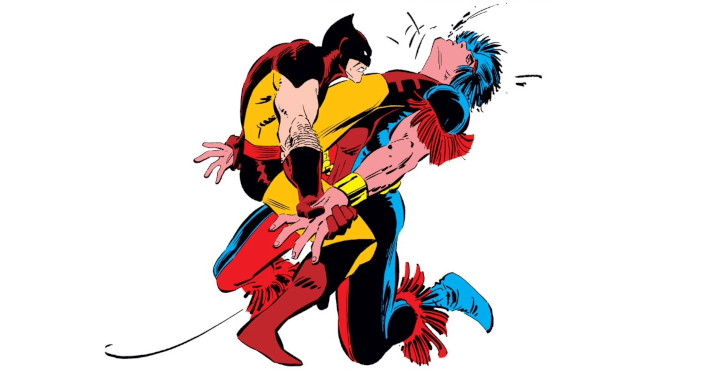
I love the omnibus format for reading comics, and I love the X-Men. Obviously, that means I’ve been collecting X-Men omnibuses. If you want a giant, high-quality book that collects a vast amount of material, and you don’t mind lugging around a tome the size of an Encyclopaedia Britannica, then the omnibus format is going to be your jam.
Now, I’ve already written up complete reviews for Uncanny X-Men Vol. 1, Vol. 2, and Vol. 3. At the time of this writing, there is no Vol. 5 (though I imagine there will be one someday), so it’s time to dig into Vol. 4 and see what it’s all about.
What’s collected in this volume?
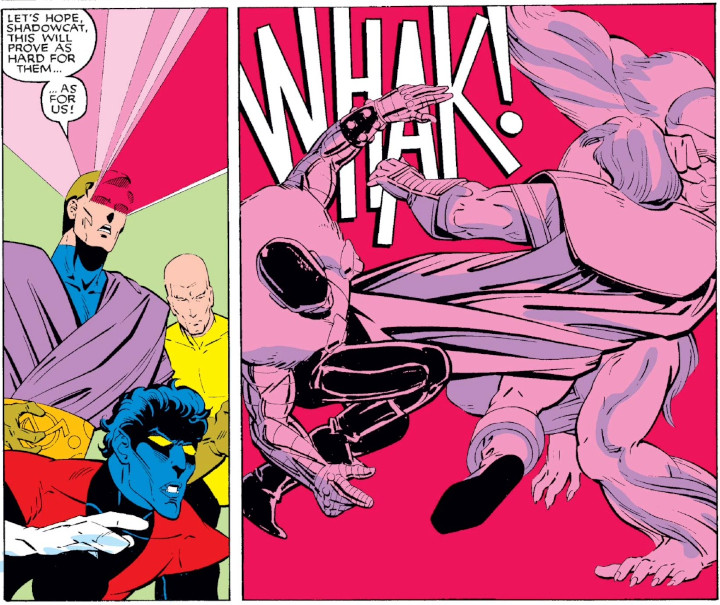
This book has 848 pages of X-Men goodness, which includes Uncanny X-Men #176-193, The X-Men Annual #8, Kitty Pryde and Wolverine #1-6, X-Men and Alpha Flight #1-2, and material from Marvel Fanfare #40.
Here’s how these stories are laid out within the book:
- Uncanny X-Men #176-188
- Kitty Pryde and Wolverine #1-6
- Uncanny X-Men #189-193
- The X-Men Annual #8
- X-Men and Alpha Flight #1-2
- Marvel Fanfare #40
The book also does include a pretty decent amount of bonus content, including a cover gallery, some pre-production art, and quite a few interviews. Oh, and the issues collected here also include the letters column from each issue, which is always appreciated.
A note on reading order…
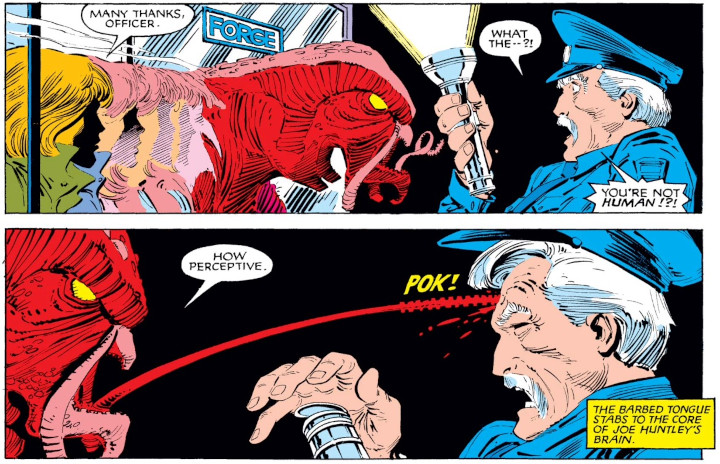
As I mentioned in my review of Vol. 3, the New Mutants series spins off of Uncanny X-Men during the Brood Saga. While New Mutants is not essential reading if you’re only interested in the mainline X-Men series, I do think the two series are best when read together. Both of them were penned by Chris Claremont, and the events of one series often spill into the other.
Further, Uncanny X-Men is interrupted by Marvel Superheroes Secret Wars, which does have some impact on the story of Uncanny. Personally, I think Secret Wars is pretty bad — I’ve read it once and I really don’t think I’ll ever read it again, even on subsequent Uncanny readthroughs. However, there are some undeniably important moments in Secret Wars that will affect certain characters for the entire duration of Uncanny X-Men Vol. 4.
With that said, I’ve put together a reading order that includes Uncanny X-Men Vol. 4, Marvel Superheroes Secret Wars, and material from New Mutants Vol. 1.
- Uncanny X-Men #176-179
- New Mutants #13-14
- Uncanny X-Men #180
- Marvel Superheroes Secret Wars (1984) #1-12
- New Mutants #15-16
- Uncanny X-Men #181-182
- New Mutants #17
- Uncanny X-Men #183
- New Mutants #18-20
- Uncanny X-Men #184
- New Mutants #21
- New Mutants Annual #1
- Uncanny X-Men #185
- “Deal with the Devil” (story from Marvel Fanfare #40)
- Uncanny X-Men #186-188
- Marvel Team-Up #149
- Kitty Pryde and Wolverine #1-6
- New Mutants #22
- Uncanny X-Men #189
- New Mutants #23-25
- Uncanny X-Men #190-192
- The X-Men Annual #8
- Uncanny X-Men #193
- X-Men and Alpha Flight #1-2
Note that I moved “Deal with the Devil” from its place in the publishing order, because it takes place during the events of Uncanny X-Men #185. It’s also really hard to place X-Men Annual #8 and X-Men and Alpha Flight for several reasons. First, this takes place before Storm leaves for Africa but after Kitty and Wolverine return from Japan. Second, Charles Xavier is present. I think the canon explanation for where these series fit is actually toward the end of Uncanny X-Men #192, but before the Charles Xavier events at the very end of the issue.
How is the quality of the physical book?
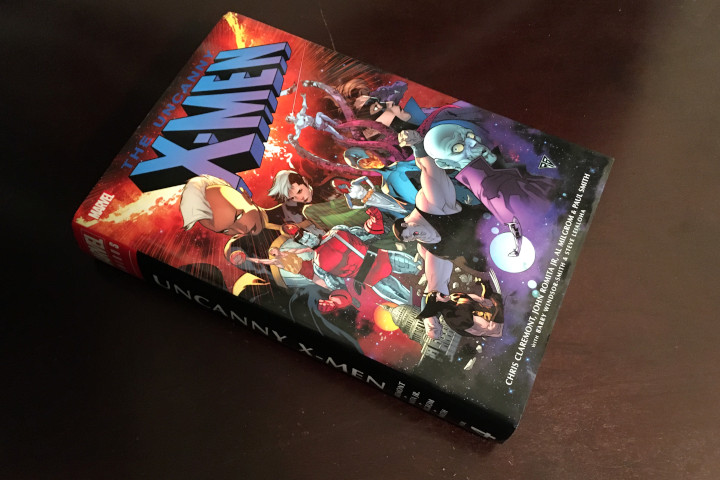
My copy of the book was manufactured between September 25 and December 7, 2020, by R.R. Donnelley Asia Printing Solutions in China. The initial release date was March 2, 2021, which means the copy I’m reviewing comes from the first printing.
The front cover (shown above) features original art by R.B Silva and Marte Gracia. There is a variant cover that uses the cover of Uncanny X-Men #193 (drawn by John Romita Jr.), but the standard cover was created specifically for this volume.
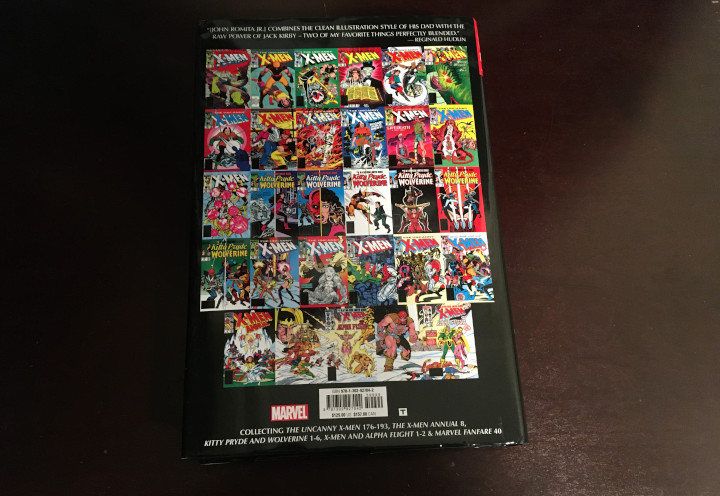
The back of the dust jacket shows the cover of every single issue collected in this book. I’ve said this before, but I love when these cover galleries are displayed on the back of the book. I think they’re really fun to look at. When you’re done reading the book, you can go back and look through the covers to get a visual synopsis of what happened in this volume, which is neat.
I’ve mentioned this several times already, so I’ll just keep this quick: Marvel changed the size of the font on the spine at some point (I think they did this toward the end of 2021). I managed to get a pre-change version of Vol. 3 and Vol. 4, and a post-change version of Vol. 1 and Vol. 2.

I don’t know why Marvel felt this change was necessary, but I prefer the older font size (the big one) to the newer size. Unfortunately, I wasn’t able to get a consistent collection, because Vol. 1 and Vol. 2 can be excruciatingly difficult to find unless you’re lucky enough to catch a reprint (I was watching the reprint market for more than a year before I was able to get my hands on Vol. 2 specifically).
To be clear, I don’t believe Vol. 4 has been reprinted with the smaller font size yet, but any reprints in the future should be expected to use the smaller font.
So, I guess I talked about that for a lot longer than I had planned. Anyway…
When you remove the dust jacket, you just have a black cover with plain white lettering.
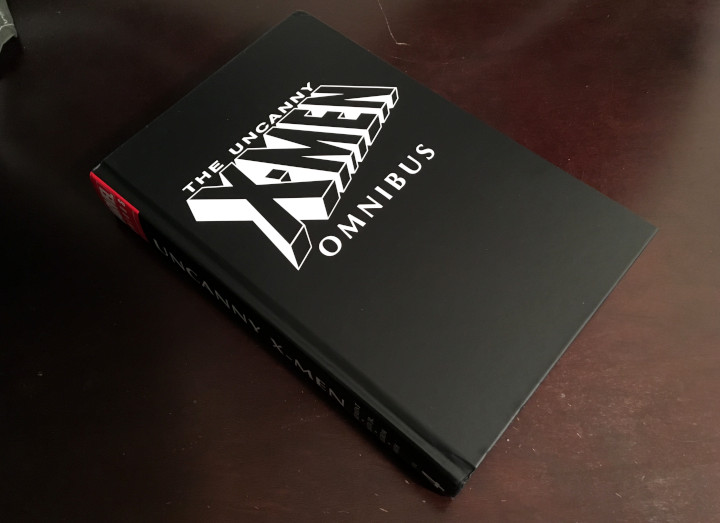
The spine does still feature the Marvel logo in red, but the rest of the cover is just black and white. The back cover is pure black with nothing on it. It’s not all that exciting to look at, to be honest, but that’s fine since the dust jacket looks pretty cool.
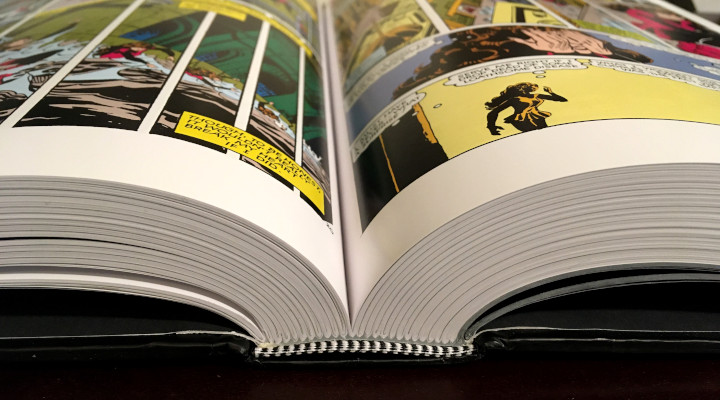
The binding is sewn and tight. The omnibus-collecting community seems torn between whether they prefer tighter bindings or looser ones that have a prominent “eye.” Personally, I like them nice and tight, and this book definitely meets that criteria. An unfortunate result, though, is that when you get to the center of the book, it’s really hard to avoid the binding creasing right down the center. Mine creased by the time I was about halfway through my first readthrough.
The paper quality is great though. As you can see in the image below, there’s very little bleedthrough.

You will notice a little bit of image bleedthrough in the white space, but hardly at all. Of all of the omnibuses I reviewed so far, this one has the highest-quality paper.
Are these stories any good?

If I’m being perfectly honest, this book feels like a sequel more than an independent collection. So much of the storylines at the beginning of this book are dealing with the fallout from things that happened in Vol. 3. The book starts with the honeymoon of Scott Summers and Madelyne Pryor (who got married at the end of Vol. 3), and it escalates the drama of Rogue forsaking the Brotherhood of Evil Mutants to join the X-Men. You also have Kitty Pryde confronted by the (extremely creepy) consequences of her deal with Caliban. So we’re talking about a good quarter of this book that is mostly just following up on things that happened in the previous volume.
I’m not saying this is inherently bad. I think these stories are great, and if you read Vol. 3, Vol. 4 is really satisfying. I’m just not sure how it might read to someone who decides to start reading X-Men here rather than with one of the previous volumes (all of which are better jumping-in points than this one).
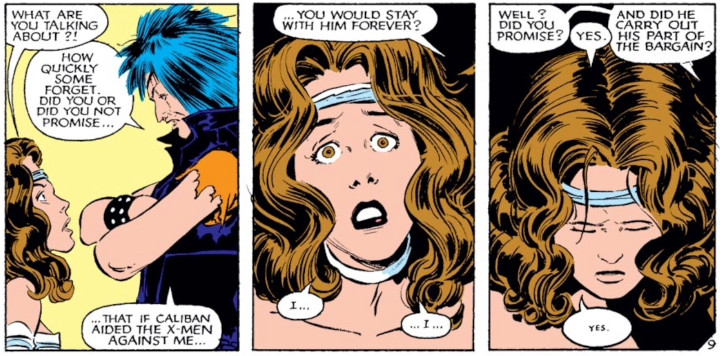
Now, if you’re wondering why Marvel decided to break these collections up this way, it’s because there was an important changing of the guard with issue #176. Here, John Romita Jr. (also known as JRJR) steps in as the primary artist on the book. To be perfectly clear, Romita did draw part of issue #175, but with #176 he became the full-time artist on the book.
As Chris Claremont notes in one of this book’s introductions, JRJR has some big shoes to fill. Previously, the only full-time artists on Claremont’s X-Men were Dave Cockrum, John Byrne, and Paul Smith. Plus, JRJR is the son of John Romita Sr., whose work on The Amazing Spider-Man was legendary. So JRJR had some big shoes to fill.
He was fully aware of this, and instead of attempting to copy any of the previous artists, he leaned very hard into his own style. He tends to use a lot of sharp edges and thinner lines, and this made for a very different look for the X-Men. Personally, I think it works quite well with these stories.
This volume features the fan-favorite “Lifedeath” story, which was penciled by Barry Windsor-Smith. I admit that this was my first time actually reading it, though I’ve been aware of it for quite some time. And it’s really good. I don’t necessarily like how dependent it is on the storyline from Rom the Space Knight, as it does feel like it’s missing a little bit of context. But overall, the story of Storm losing her powers is a compelling and emotional one. I’m glad to have finally read it, and I can see why it’s so highly regarded among X-readers.
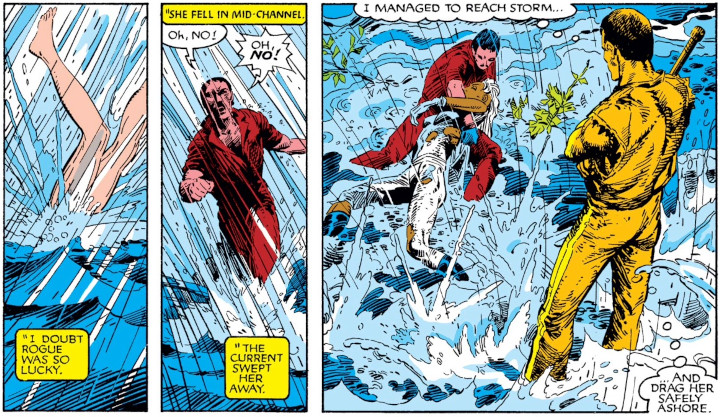
After this, there’s the Kitty Pryde and Wolverine miniseries, which is really just a Kitty Pryde series that has Wolverine show up about halfway through. It sends Kitty and Wolverine back to Japan, so it feels a little bit like a follow-up to the Wolverine miniseries (which was collected in Uncanny X-Men Vol. 3), but the Wolverine miniseries is better than the Kitty Pryde and Wolverine miniseries, in my opinion.
Toward the end of this volume, you have X-Men Annual #8, which is just Illyana telling a campfire story about Kitty. This is interesting from a framing perspective, because way back in Vol. 2 there was a story where Kitty told Illyana a bedtime story. Back then, Kitty was a teenager and Illyana was a small child. Since then, Illyana spent seven years in the demonic Limbo dimension, where time flows differently than in our dimension, and she emerged just a few weeks later in our time, but had aged seven years. So now she and Kitty are close to the same age. So Illyana telling Kitty a story to comfort her is a reversal of something that happened several years earlier. I like this as a storytelling device, but I also think this story is mostly skippable (there is an important moment between Kitty and Colossus toward the end, though).
There’s also a really bizarre story where a sorcerer named Kulan Gath blasts a chunk of Manhattan back into the Middle Ages. When someone walks through the membrane between worlds, they forget who they were in the modern world and revert to a Medieval version of themselves. Because Charles Xavier is potentially his most dangerous adversary, Kulan Gath merges him with Caliban, whose cowardice mitigates Xavier’s boldness. This creates a visually striking version of Xavier with Caliban attached to his chest.
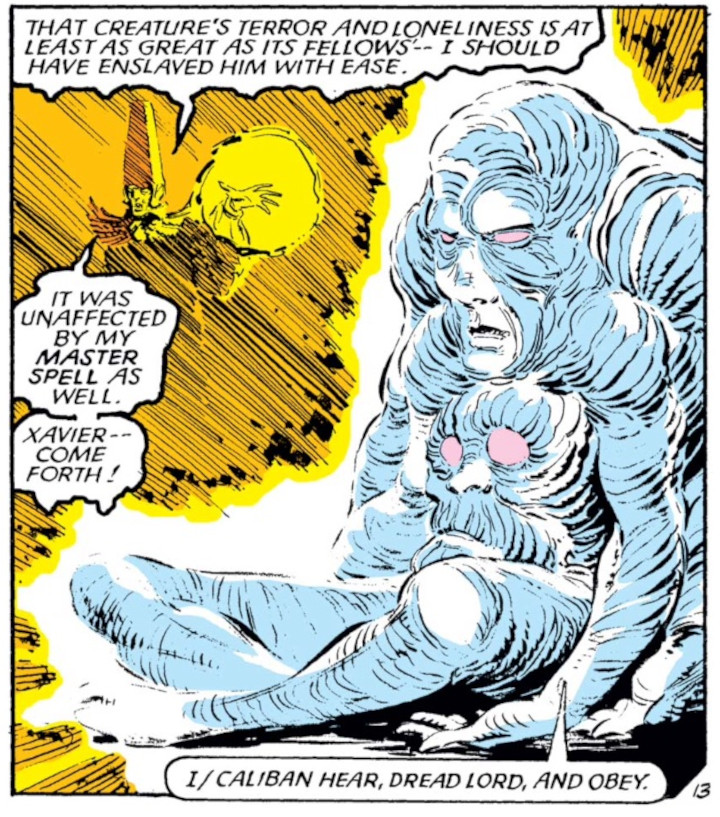
It’s so weird and disorienting, and I kind of love it.
This volume also includes Uncanny X-Men #193, which is the 100th issue of Uncanny since the reboot. In celebration, this was a double-sized issue that brought the X-Men back to the NORAD facility, where Thunderbird famously died shortly after the reboot. They encounter James Proudstar — the brother of John Proudstar (AKA Thunderbird) — who believes Xavier to be responsible for his brother’s death. It’s quite a callback, and appropriate for a double-sized anniversary-themed issue.
And then there’s the X-Men and Alpha Flight two-issue miniseries, which finds the X-Men in an impossible Utopia where pain and suffering can be irradicated from the world, but at the expense of magic. This ends up being one of Loki’s tricks, but even when that’s revealed, a lot of characters find it difficult to reject this world that feels too good to be true. It’s a really weird story, and coming so close after the saga of Kulan Gath, it’s feeling like X-Men is just getting weirder and weirder at this point.
I should point out that the X-Men and Alpha Flight series was intended to kick off a new superhero team called the Berserkers (not to be confused with the Black Berserkers), and this team would have included Madelyne Pryor. As far as I can tell, the Berserkers never actually became a thing, but it’s interesting watching the creative team at Marvel scramble to figure out what to do with Madelyne.
As we get toward the end of this volume, an extreme anti-mutant sentiment is growing among the populace, and the Morlocks are becoming staple characters. In retrospect, we can clearly see that this is setting up the Mutant Massacre, though we’re not quite there yet. But the chess pieces are certainly moving into place for the first major X-Men event.
Is this a good place to start reading X-Men?
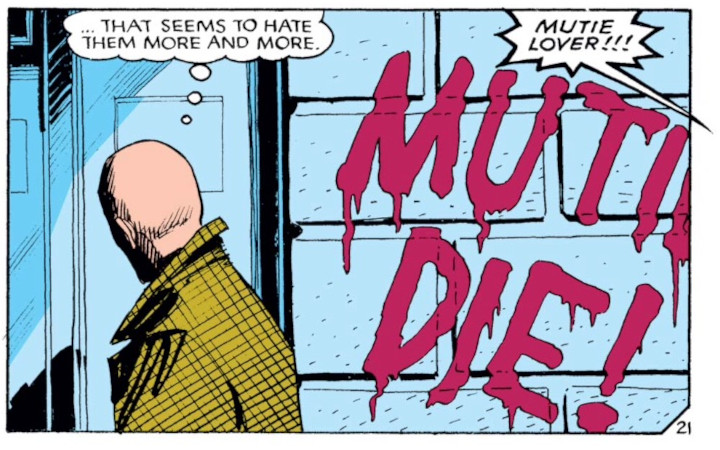
Okay, so I’ve read all four volumes of Claremont’s Uncanny X-Men omnibuses at this point. Yes, four. I acknowledge that there are several more Claremont omnibuses after this, but they drop the Uncanny title, and we can probably expect a Vol. 5 at some point in the future. At the time of this writing, the next omnibus is Mutant Massacre, and there’s plenty of content between Vol. 4 and Mutant Massacre that’s not yet collected in omnibus format.
That said, you would probably be fine starting with any of the previous volumes as a jumping-in point. Vol. 1 is clearly the best spot to begin if you’re a completionist, but Vol. 3 is also a good entry point — especially with the entries from The Official Handbook of the Marvel Universe (1983-84) at the back of the book. And even though Vol. 2 starts kind of in the middle of the Dark Phoenix Saga, it doesn’t feel too difficult to fall into the groove at that point.
Vol. 4 is different. This volume is incredibly self-referential, and a lot of it is dealing with things that happened in the previous volume. It really does feel like Vol. 3 is essential reading if you want to get the best experience from Vol. 4.
Also, this volume doesn’t have the high-caliber, iconic stories that the previous volumes had. There’s no Dark Phoenix Saga or Brood Saga or Days of Future Past. The one exception, of course, is “Lifedeath,” but I don’t know how enjoyable “Lifedeath” would be for anyone who hasn’t been following the metamorphosis of Storm that began in Vol. 3.
So no, I wouldn’t recommend Uncanny X-Men Vol. 4 as a starting point for reading Claremont’s X-Men. I would, however, absolutely recommend it for anyone who loved Vol. 3, as this really feels like the missing second half of that volume. It’s not quite as good as Vol. 3, and it gets pretty weird toward the end, but it really does carry forward the storytelling momentum of the previous volume.